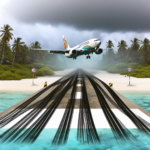DUBAI- The international airline industry achieved a remarkable milestone in 2024, surpassing pre-COVID-19 air travel levels for the first time. Middle Eastern airlines and airports, notably Qatar Airways (QR), have been securing a growing share of international business during the recovery stage.
The IATA reported that full-year traffic rose by 3.8%, indicating a full recovery for the industry following the pandemic’s significant challenges.
The geographical advantages of the Middle Eastern region include considerable wealth, easy access to three continents, and ambitious plans for airline expansion.
European carriers are confronting increasing difficulties from heightened environmental taxes and restricted airspace over Russia resulting from the Ukraine conflict. The dense population in Western Europe further limits airport expansion opportunities, creating additional competitive challenges.
Qatar Airways (QR) has positioned itself as a major beneficiary of this shifting landscape. CEO Badr Mohammed al-Meer announced in March that the airline is in talks with manufacturers to enhance annual passenger capacity from 50 million to 80 million by the end of the decade. This expansion will include a strategic pause once Hamad International Airport (DOH) in Doha reaches its operational limits.
In mid-May, the airline reaffirmed its growth strategy with a significant announcement regarding a Boeing order during President Donald Trump’s Gulf visit. Qatar Airways (QR) committed to acquiring up to 210 Boeing 777X and 787 Dreamliners in a deal worth $96 billion, marking one of the largest aircraft orders in aviation history.
Record Financial Performance
In May, Qatar Airways Group reported outstanding financial results, achieving annual profits of QR7.85 billion ($2.15 billion) for the 2024-25 fiscal year.
This represents an increase of over QR1.7 billion ($500 million) compared to the prior year.
Qatar Airways Cargo significantly contributed to this success, reporting a 17% increase in revenue, underscoring the strength of its freight operations.
Service Quality
Al-Meer highlighted that maintaining high service quality is a crucial competitive advantage, mentioning that some airlines have compromised their standards during rapid growth phases.
Airlines are increasingly committed to enhancing passenger connectivity by introducing better Wi-Fi services, with many looking into Starlink satellite networks to tackle current weaknesses in inflight internet connectivity.
Qatar Airways’ pursuit of premium service necessitates operating the latest aircraft throughout its network. The airline’s extensive fleet and the average lifespan of its aircraft, approximately 20 years, create opportunities for it to establish a leasing division, potentially offering older aircraft to budget airlines. Doha’s ideal location and rigorous maintenance standards make it well-suited for aircraft leasing ventures.
Technology
Aviation authorities are adopting robotics and artificial intelligence to optimize security clearance processes at airports.
Advanced AI technologies are capable of detecting prohibited items via x-ray imaging, while facial recognition systems aid in identifying individuals on security watchlists, thereby minimizing passenger inconveniences during screenings.
Sustainability Concerns
The recent sidelining of sustainability and net-zero emissions as primary business priorities has played a role in the resurgence of air travel, though the development of renewable technologies is ongoing.
Although zero-carbon commercial flights are still years away, energy efficiency remains a key factor influencing aircraft viability. Engine manufacturers have made notable strides in fuel efficiency that directly impact operational expenses.
Historical Aircraft Investments
Two notable aircraft programs illustrate the industry’s intrinsic risks. Both Concorde in the 1970s and the Airbus A380 in the 2000s experienced far lower sales than anticipated, largely due to their inferior energy efficiency compared to competitors. Additionally, Concorde faced challenges related to noise and air pollution concerns.
These investments highlight a fundamental challenge in the industry: aircraft development demands billions of dollars over several years amid unpredictable market conditions. Unforeseen disruptions, such as the 2008 financial crisis and the 2020-2022 pandemic, can have severe effects on travel demand.
Stay connected with us for further updates. Follow us on social media for the latest news.
Join us on Telegram Group for the Latest Aviation Updates and follow us on Google News.

Sakshi is an aspiring DGCA Commercial Pilot navigating her path into the Indian Aviation industry. An aviation enthusiast, she also expresses her creativity through engaging articles and short stories while nurturing a passion for sports, fitness, and the innovations of Elon Musk’s Tesla.
Based on an article from aviationa2z.com: https://aviationa2z.com/index.php/2025/05/29/qatar-airways-leads-international-travel-with-new-growth-strategy/?utm_source=rss&utm_medium=rss&utm_campaign=qatar-airways-leads-international-travel-with-new-growth-strategy



